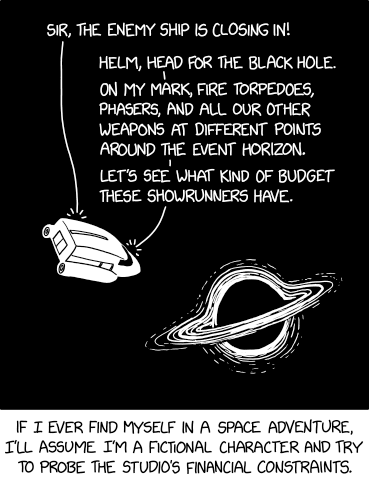Space Adventure

"Sir, it looked really cool." "Oh no--prestige TV. Okay, which of you has a terrible secret that's being slowly revealed to the audience through flashbacks? Just spit it out so we can escape this arc!"

"Sir, it looked really cool." "Oh no--prestige TV. Okay, which of you has a terrible secret that's being slowly revealed to the audience through flashbacks? Just spit it out so we can escape this arc!"
This comic references space adventure television series and appear to show a typical scene from such a series: The trope of the vessel (in this case a relatively powerless shuttlecraft modeled after the Star Trek Original Series shuttle Galileo) evading combat with some unseen but presumably more battleworthy enemy vessel by fleeing into some form of 'space geography' that the heroes think, or hope, they can hide in or fly through more successfully than their pursuers can find or follow them in. Oftentimes a negative space wedgie (Deus ex machina) or some nebulous form of canyon-run, but if it is an actual black hole (within which the use of fantastical physics is intended to provide some sort of uncertain plot-armour) then often it's a swirly-effect meant to appear to be some kind of cosmic plughole. And this is the escape-route (or hiding place) that this particular ship seems about to try to take advantage of.
The command to head towards the black hole normally promises some (fictional) manner of breaking physics to survive the phenomenon, but is instead followed up by a command that seems intent to break the Fourth Wall. i.e. assuming that this is a fictional scenario and intending to establish exactly what kind of fictional scenario it is. By attempting to interact with the black hole in the most computationally intensive way possible (firing all kinds of weaponry at it, in distinctly different ways) they 'aim' to find out how thoroughly accurate their fictional existence actually is, potentially to test the in-universe physics and find out with which method their in the real world unsurvivable situation might be escaped from.
(We can already see that it is the imagery of a black hole (or, rather, the hot matter still visible as swirling around its event horizon) featured in the film Interstellar, a high-budget blockbuster which famously created this particular effect from the calculations of actual professional physicists. Although Randall has also used the actual imagery of a black hole, elsewhere.)
Exactly how this helps the crew and passengers, is unclear, but being genre-aware (or not) can have implications for how characters manage to handle the problems that crop up in their various plotlines. The title text indicates that the resulting effects "looked cool", which may not necessarily indicate particular accuracy to 'real life' but indicates at least that the showrunners are taking this fiction seriously. It leads on to the assumption that there is one key piece of information, that one of those present possesses, which has some bearing on their current predicament. And they are going to be in peril from all kinds of 'monsters of the week' or other nemeses at least until they learn what that is, so perhaps they could skip much of the danger just by a more immediate revelation.
“Prestige TV” is another name for the present Golden Age of Television, which started around the year 2000. Golden Age television shows are more likely to have better special effects (more high-quality post-processed Computer-generated imagery (CGI), rather than 'green screen' background replacement or even a purely practical effect such as 'suitmation' or other modelling) which contrast greatly with the effects of earlier eras. The ability to show weapons being fired, and even some more intuitive-looking emulation of physics, has improved as the production technologies have improved, and potentially made sufficiently good-looking special effects cheaper — certainly more ubiquitous. This then may be considered a co-indicator towards the tendency of newer and more 'cool' looking shows to also develop complex interwoven season-long (or even whole-series) story arcs, which build upon multiple cliff-hangers and situational developments for the characters involved. This is as a contrast to the more traditional stand alone episodes of drama, from earlier decades, that almost always resolve in precisely the conclusive manner that leaves the characters mostly in the same frame of mind as in the start – such that they arrive fresh in the next episode, or indeed any further episode, under virtually the same pretextual scenario.
The other portion of the title text seems to refer to a relatively common trope of internal conflict being somehow related to external conflict, and the increasingly common trope of having a character with a *mysterious past* they've conveniently forgotten slowly rediscover, and grapple with, who they were, the culmination of that character arc often setting up the group of protagonists to be able to defeat the Big Bad Evil Guy (BBEG) or somehow escape the situation they're in.